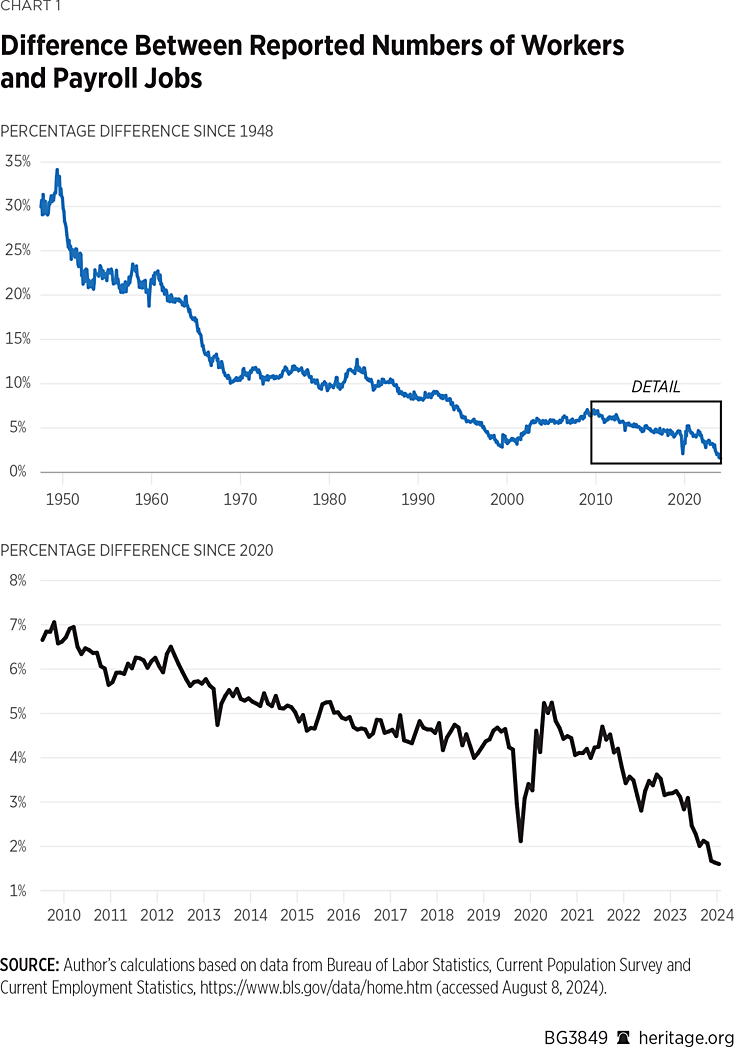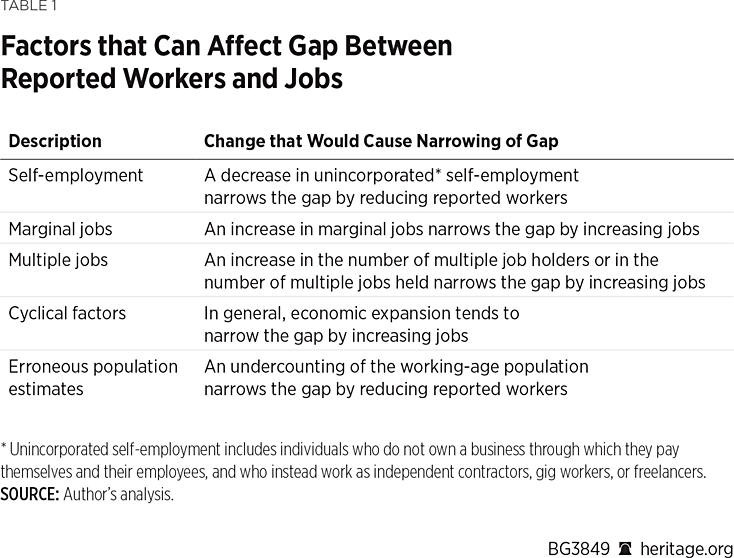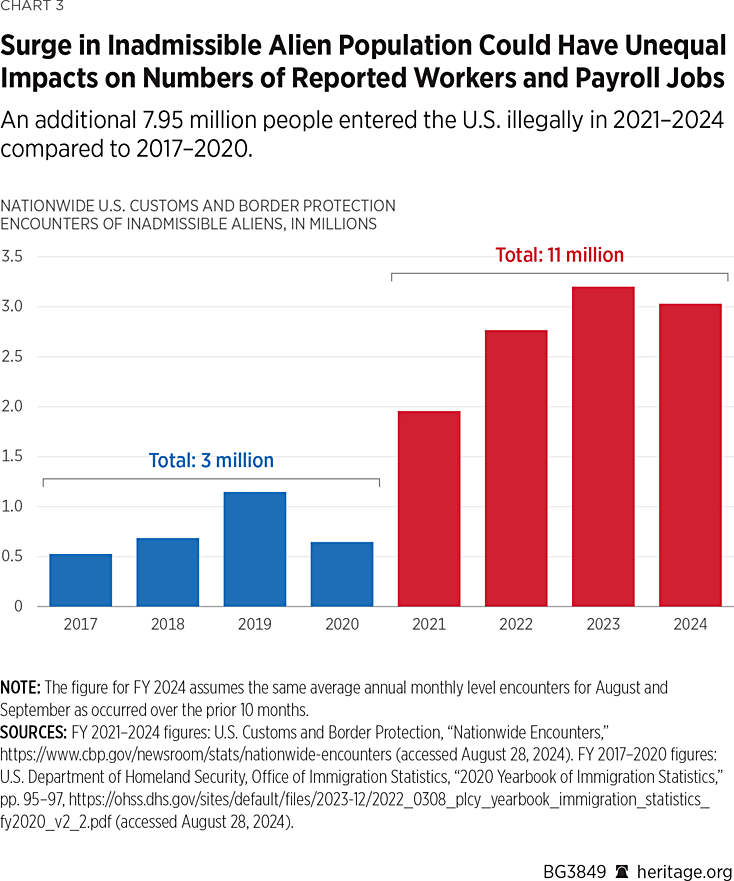The Bureau of Labor Statistics announced a major downward revision of its reported payroll job gains, effectively wiping out 28 percent of the past year’s reported gains. These overstated job gains play into a recent multiyear trend in which reported payroll jobs have risen twice as fast as the reported number of additional people working in the United States. This raises the question of which data report—the survey of employers’ payrolls or the survey of household employment that estimates the number of workers—best reflects the U.S. labor market.
Historically, the two different government reports have always shown that the number of people working in the United States exceeds the number of jobs on companies’ payrolls primarily because not all jobs are payroll jobs. Although this is still, just barely, the case today, the gap between workers and payroll jobs (reported in the monthly jobs report) has narrowed to a historical low of 1.6 percent compared to an average gap of 5.2 percent over the past two decades.REF
This declining gap means a significant divergence between the number of reported payroll job gains and new workers, which raises the question: Is the labor market strong, having added 7.8 million new payroll jobsREF over the past five years,REF or is it lacking, with only 3.7 million more workers out of an increase of 9.4 million in the working-age population? The answer is almost certainly a little of both, with the economy having fewer payroll jobs than reported and potentially more workers than are counted.
This Backgrounder examines historical trends in payroll jobs and total employment and considers potential reasons for today’s unparalleled gap.
Two Distinct Measures: Payroll Jobs and Employed Workers
The monthly “jobs report” from the Bureau of Labor Statistics includes data from two different surveys. The number of jobs gained or lost comes from the establishment survey that polls nonfarm employers, asking them how many people are included in their payrolls. The number of employed workers, along with the unemployment rate, comes from the household survey that asks individuals about their work, including if they are working and if they are looking for work.REF
The number of people working (household survey) exceeds the number of jobs (payroll survey) primarily because not all workers earn their income from traditional payroll jobs. Those who are self-employedREF or independent contractors do not show up in payroll jobs. A number of other factors—both structural and cyclical—can also affect differences between the reported numbers of workers and payroll jobs.
Historic Trends
In the late 1940s, when a comparatively high percentage of Americans worked in farming or for themselves, the number of workers exceeded payroll jobs by more than 30 percent. The gap between payroll jobs and employment declined significantly to around 10 percent by 1970 and remained in a range of 9 percent to 11 percent until 1990. The gap further declined throughout the 1990s, falling to 3 percent by 1999,REF but then rising again throughout the 2000s.
Since 2000, the number of employed people has exceeded payroll jobs by an average of 5.0 percent. Over just the past two years, however, the gap between workers and payroll jobs has plummeted to an all-time low of 1.6 percent.

Potential Reasons for Gaps
Jobs and employment data can differ for multiple reasons, including differences in the classification of jobs and the treatment of multiple job holders, differences in survey methodologies, cyclical factors, and potentially demographic changes.
Self-Employment. Self-employed workers—be they consultants, small business owners, construction workers, writers, language interpreters, yoga instructors, or gig workers—are all counted as workers in the household survey. The employer payroll survey, on the other hand, includes only incorporated self-employed individuals who are technically payroll employees of their own companies. To the extent that more people perform unincorporated self-employed or independent work instead of traditional payroll jobs, the number of employed people will rise relative to payroll jobs. In contrast, if fewer people make a living working for themselves, the gap between workers and payroll jobs will decline.
Marginal Jobs. While the number of workers exceeds the number of payroll jobs, it is possible for individuals to register as having a payroll job despite reporting that they are not employed. As economists who examined survey gaps explained, this is more likely to be the case for “short-term, low-hour or low-earnings jobs” because either individuals in those jobs do not consider work to be their primary activity or the short-term duration may mean that the individual no longer held the reported job at the time of the employment survey.REF
Two or More Jobs. Again, although employment exceeds jobs, another way that jobs can instead exceed employment for a particular group is when individual workers hold two or more jobs. While there can be no double-counting of individual workers, someone who holds two or even three part-time jobs will register multiple times in the payroll jobs data.
Cyclical Changes. Historically, the gap between the numbers of reported workers and payroll jobs tends to decrease during economic expansions as payroll jobs rise faster than the number of workers, and in turn, rises during recessions and early recoveries as payroll jobs decline by more than the number of workers. For example, if businesses respond to increased demand during an economic expansion by hiring additional part-time and short-term positions to meet that demand, or if they convert independent contractors with whom they do business into formal payroll employees, payroll jobs rise by more than the number of workers.
Cyclical changes are not necessarily straightforward in direction, however, and government policies can alter how employers respond to economic expansions or downturns. For example, the combination of taxes and labor regulations can incentivize an employer to respond to an economic downturn by converting one full-time job with benefits into two part-time jobs without benefits, thus countercyclically reducing the gap during an economic contraction.
Erroneous Population Estimates. Whereas both the employer payroll survey and the household survey sample representative populations, the payroll survey captures a significantly larger portion of total payrolls and is benchmarked annually to unemployment insurance tax records, while the household survey is formally benchmarked only every 10 years based on the decennial census. Inaccurate annual population estimates can lead to inaccurate employment estimates. For example, an undercounting of the working-age population in the mid- to late 1990s caused low employment estimates.REF

What Is Happening Today? Workers and Payroll Jobs
The recent plunge in the gap between jobs and workers likely stems from more than one factor, and it is too soon to determine the precise cause. While at least one factor—impending payroll job revisions—is a known contributor, the other potential factors will require additional time and data to construe.
Benchmark Payroll Revisions. One known source of the declining gap is a recently acknowledged overstatement of 818,000 new payroll jobs that is not yet reflected in the official data. Each year, the payroll jobs data is benchmarked, or standardized, based on more comprehensive payroll data tied to unemployment insurance records. The preliminary annual benchmark revision for 2024 indicated a downward revision of 818,000 payroll jobs, meaning that of the reported 2,900,000 additional payroll jobs created between March 2023 and March 2024, 28 percent of them were overstated—meaning they were likely not actually created.REF This reduction in payroll jobs will not be incorporated into the payroll jobs data until February 2025. If the current payroll jobs reflected this 818,000 downward revision, the current gap would be 2.1 percent instead of 1.6 percent.REF

Mismeasured Population Estimates and a Rise in Illegal Immigration. The data on employed workers combines the household survey with the Census Bureau’s population estimates. If the census population estimates are off, the Bureau of Labor Statistics’ estimates of workers will also be inaccurate.
While no census is perfect, the 2020 census was less accurate than most. Among the problems the Census Bureau identified was a significant 5 percent undercount of the Hispanic population.REF A Pew Research Center report about the quality of the 2020 census posited that Hispanics and other racial groups that were undercounted “are less likely to fill out census forms and respond to census workers who come to the door for reasons that could include lack of trust and feelings of disconnect when it comes to the government.”REF
The recent increase in illegal immigration—including an estimated 11 million individuals entering the United States illegally between fiscal years (FYs) 2021 and 2024,REF compared to 3 million between FY 2017 and FY 2020REF—has shifted the demographic makeup of the United States, and it is unclear to which extent the reported payroll jobs or workers capture this shift.REF

While neither the payroll jobs survey nor the household workers survey asks about residency status, the Bureau of Labor Statistics acknowledges, “It is likely that both surveys include at least some undocumented immigrants,” but “it is not possible to determine how many are counted in either survey.”REF
One way that the rise in illegal immigration to the United States would lead to a decline in the gap between reported workers and payroll jobs is if work done by individuals residing in the United States illegally shows up more in the employer survey of payroll jobs than in the household survey of workers.
A Goldman Sachs Economics Research Q&A on the downward revision to payroll jobs suggested that this is the case, noting that “we suspect many businesses that employ immigrants who are not authorized to work report their total headcount accurately to the Bureau of Labor Statistics for the payroll statistics, which is riskless, but omit most of them from the state unemployment insurance forms—which generally require names and Social Security numbers—that provide the source data for the Quarterly Census of Employment and Wages used for the benchmarking.”REF Goldman Sachs state- and industry-level analysis supported this view, as states and industries with more unauthorized immigrants experienced larger downward revisions to payroll jobs.REF
Meanwhile, while the data do not exist to confirm this hypothesis, the census undercount of the Hispanic population and the potentially lower response rates of individuals who entered the United States illegally suggests that the household survey could be undercounting this group of workers by a greater degree than in the past and thus potentially contributing to the declining gap between reported payroll jobs and workers.
Potential Decline in Self-Employment. The advent of app-based platforms for individuals to sell their products or to find gig jobs contributed to a significant increase in independent work over the past decade. In 2023, an estimated 64 million Americans—more than one in three workers—participated in independent work.REF For most, independent work was part-time or alongside a traditional job, but a growing number of Americans have chosen to give up their traditional jobs to become their own bosses.
Recent government actions seeking to “crack down” on alleged worker misclassification have made it harder to make a living or obtain additional income as an independent contractor. California was the first state to pass a major law restricting independent contracting. Although that law already has more than 100 exemptions, a recent economic study found that the restrictions led to a 10.5 percent decline in self-employment in the state and a 4.4 percent decline in total employment.REF That impact registers as a narrowing of the gap between workers and payroll jobs.
At the federal level, the Biden–Harris Administration imposed significant limits on independent contractors through a rule that went into effect in March 2024.REF While it is too soon to conduct an economic analysis of the impact of that rule, it may have contributed to the narrowing gap.
Increase in Multiple and Marginal Jobs. At 5.2 percent in July, the percentage of workers who hold two or more jobs is not especially high by historical standards, but it has increased over the past two years. Compared to 4.8 percent of workers holding multiple jobs two years ago and 5.0 percent holding multiple jobs one year ago, additional multiple jobs could account for at least 324,000 (13 percent) of the 2,512,000 payroll jobs added over the past year and could account for at least 648,000 (11 percent) of the 5,685,000 payroll jobs added over the past two years. The impact of multiple job holders driving up payroll jobs relative to workers could be even larger if there has been an increase in the number of workers holding three or more jobs.
“Marginal jobs,” which involve relatively few hours and could be sporadic, can increase the number of payroll jobs without increasing employment, because they are more likely to represent multiple jobs, and individuals with only one marginal job that they do not consider to be substantial employment may report that they are not working.REF The official data do not provide information to determine whether there has been an increase in marginal jobs.
Policies to Maximize Work, However It Is Measured
Whether looking at the number of payroll jobs in the economy or the number of people who report that they are working, strong employment is crucial to a country’s economic growth and endurance. Someone who works in the formal labor market produces goods and services that are of value to others, receives income to provide for himself and his family, and pays taxes to fund government services. Someone who neither works in the formal economy nor cares for family members nor volunteers his services does not create value for others, does not earn an income to support himself and family, and likely consumes other taxpayers’ dollars through welfare programs. Thus, moving idle Americans into work provides a double boost to economic output and government budgets.
To help to make work more widespread and profitable, policymakers should:
-
Expand Alternative Education Options. Apprenticeships are a proven alternative to degree programs, and a 2017 study estimated that the number of occupations commonly filled through apprenticeships could nearly triple, that the number of job openings filled through apprenticeships could expand eightfold, and that the occupations ripe for apprenticeship expansion could offer 20 percent higher wages than traditional apprenticeship occupations.REF Yet, the federal government’s effective monopoly on registered apprenticeship programs has prevented apprenticeships from being a viable education option for most workers. The Biden–Harris Administration doubled down on that restrictive, monopolistic framework by cancelling the Trump Administration’s new and growing Industry-Recognized Apprenticeship Programs,REF proposing an apprenticeship regulation that prohibits two of three existing Registered Apprenticeship Programs, and issuing an executive order that discourages companies from starting their own, non-government-registered apprenticeship programs.REF In contrast to the Administration’s restrictions on apprenticeships, the Apprenticeship Freedom ActREF and the Training America’s Workforce ActREF would enable apprenticeships to expand across more industries so that more young people can access on-the-job, paid education ending in successful careers.
-
Not Restrict Job Opportunities. Many Americans want or need more flexibility than a traditional nine-to-five job provides. More than half of the 64 million Americans who perform freelance work say that they are unable to work in traditional jobs because of their personal health or their family caregiving needs.REF And economic studies show that flexibility increases the number of people who can work, as well as the hours that people work.REF In contrast to California’s AB 5 law, which reduced employment, and the Biden–Harris Administration’s regulation restricting independent contracting, the 21st Century Worker Act would provide a clear and logical definition to determine who is an “employee” and who is an “independent contractor,” with deference to workers’ preferences in cases of ambiguity.
As younger workers’ employment has experienced some of the steepest declines, policymakers should not impose mandates, such as high minimum wages, that make it harder for individuals to get their foot in the door, to earn income to support their future endeavors, and to gain the experience they need to climb the career ladder.
-
Make Welfare Work-Oriented and More Effective. The primary goal of welfare should be to help individuals and families to thrive by empowering them, through work, to earn a living that allows them to make their own decisions and pursue their own goals. In addition, the web of more than 90 federal welfare and workforce programs needs to be simpler and more effective at helping people gain independence. Utah’s “One Door” model—which integrates all welfare and workforce supports into a single “Department of Workplace Services” whereby Utah residents walk through one door and work with one employment counselor—provides a successful framework.REF If U.S. employment matched that of Utah, 12.6 million more people would be working today.REF Policymakers should eliminate the current federal prohibition that prevents other states from being able to pursue Utah’s successful “One Door” model. That could be done by amending the bipartisan Stronger Workforce for America Act so that all states—not just a few—can pursue Utah’s model.REF
-
Make Work Pay by Reducing Government’s Take. In general, higher compensation increases workforce participation. But excessive government regulations cause workers’ paychecks to start out smaller than they could be, and government taxes directly take away from workers’ paychecks. A 2023 analysis by the National Association of Manufacturers estimated that the average U.S. employer pays about $13,000 per employee per year to comply with federal regulations, many of which are excessive and provide no benefit to workers.REF Moreover, the federal government directly takes $14,200 in taxes from the median worker’s $59,400 of annual earnings.REF If the Tax Cuts and Jobs Act provisions are not extended beyond 2025, the federal government’s take will increase by $1,300 to $15,500 in federal taxes.REF Policymakers should eliminate unhelpful regulations that needlessly restrict workers’ compensation and minimize federal taxes and spending so that workers can keep more of the paychecks they earn.
Conclusion
The recent and unprecedented divergence between payroll jobs and employed workers calls into question the true state of the U.S. labor market. Payroll job growth has been overstated, and an increase in people holding multiple jobs and marginal jobs could be further increasing payrolls without affecting employment. Simultaneously, new government restrictions on self-employment may be reducing total employment without reflecting payroll job losses. Lastly, inaccurate population estimates and the recent surge in illegal immigration may be causing an understatement in the number of people who are working.
Work is fundamental to human flourishing. Regardless of differences in official statistics, policymakers should seek to make it easier and more rewarding for people to work and harder for them to sit idly on the sidelines. That includes expanding alternative education options, such as apprenticeships, not restricting flexible work or entry-level jobs, and making welfare work-oriented. Moreover, by eliminating unnecessary regulations that restrict workers’ compensation and by limiting the government’s direct take from workers’ paychecks, policymakers can help to make work pay for more Americans.
Rachel Greszler is Senior Research Fellow in Workforce and Public Finance in the Thomas A. Roe Institute for Economic Policy Studies at The Heritage Foundation.




